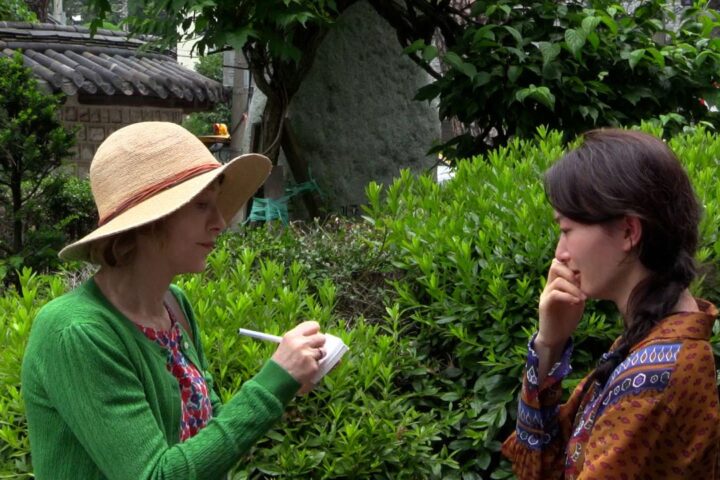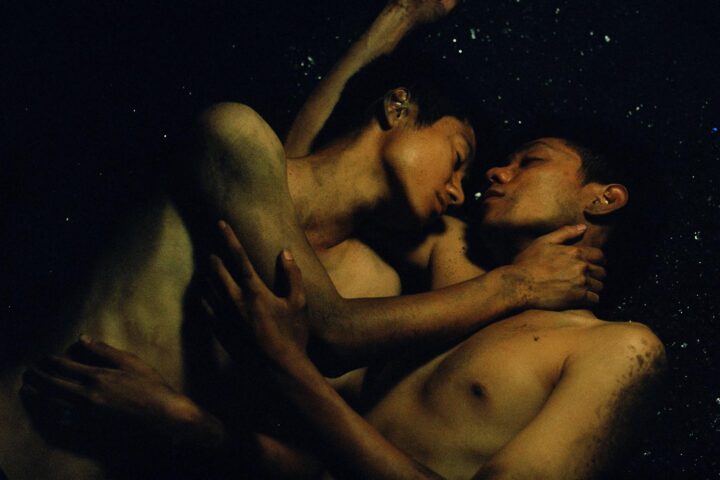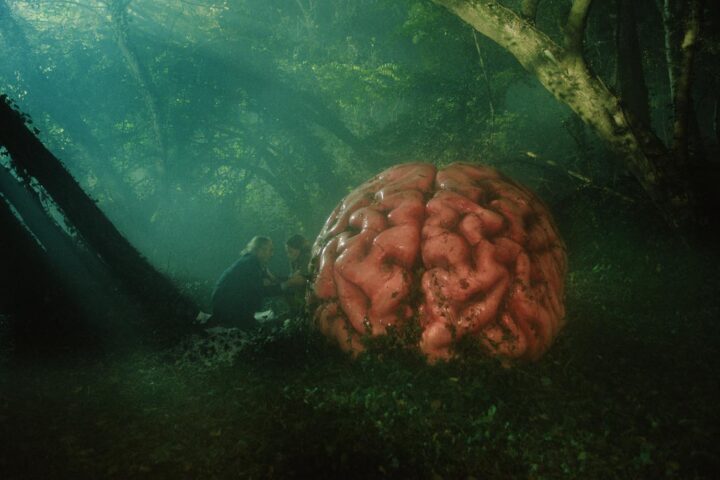Writer-director Hong Sang-soo’s By the Stream opens on a pastoral autumn landscape of Seoul, with a stream running toward a bridge. Wide landscape shots are unusual for Hong, and this image introduces this stream as the first of several refrains that will run through the film as, well, currents. Amid a vast narrative, especially for Hong, one that’s rich in scandals and disappointments and broken promises, there’s the relief for the characters of the stream, the foliage, and the moon. As despairing as this film can be, it also has a glow that’s reminiscent of Hong’s In Front of Your Face, only more so. This is the glow of communal rapture, the reassuring bond of community that can also be a trap.
Sitting by the stream is Jeonim (Kim Min-hee), who’s writing in a notebook, seemingly lost in reverie. Hong and Kim express more with such an image than most filmmakers do with pages of dialogue. Somehow, even from afar, one can sense a wounded quality in Jeonim. Or at least viewers can if they have familiarity with Hong’s films, as Kim, Hong’s personal and creative partner and muse, as well as one of the subtlest and most cutting actresses of her generation, is a specialist in playing artists who’re on the cusp of a midlife crisis.
Not long after this opening, Jeonim meets with her uncle, Chu Sieon (Kwon Hae-hyo), outside of the university where she teaches. He’s a celebrated television actor and director whose career was ruined due to murky circumstances. Hong revisits this setback several times over the course of By the Stream, and it sounds as if Chu Sieon staged a work with a political undercurrent that offended someone in power. The nature of Chu Sieon’s rebellion and the identity of the persons who halted his career remain pointedly abstract. Hong is interested in the emotional tension brought about from someone’s fallout, mining the cloud of resentment and futility and insinuation that can mark someone in the midst of retreat from controversy. Kwon, another member of Hong’s stock company, is a specialist in embodying such tension.
And this tension, carried in the film primarily by Chu Sieon and intensified by Jeonim’s contradictory behavior toward him—sometimes she’s eager for approval, sometimes she’s resentful, sometimes she’s both—is complicated further by another scandal and its own ambiguities and reverberations. Niece and uncle are united here because a director (Ha Seong-guk) of a skit for a university ceremony was discovered to be romantically fraternizing with several students and dismissed. Tasked with replacing the former director, Jeonim turns to Chu Sieon, who now runs a remote bookstore in another part of the country.
On paper, By the Stream sounds like a culture war thriller, something akin to a Notes on a Scandal or The Human Stain for the Me Too era. The film is that, to an extent, but it moves and breathes like most of Hong’s work, following characters over the courses of long and boozy dinners in which they reveal their souls with disconcerting suddenness.
In any moment, a Hong character will be discussing the joy of eating eel or drinking wine, only to let slip, say, a remembrance of the time that her body viscerally rebelled against the way she was living her life. It’s Hong’s refusal to tonally differentiate idle talk of eel from a personal confession that is audacious and integral to his originality as an artist. He allows all sorts of emotions and tones to bleed bewilderingly together as they do in actual life.
Certain critics have condescended to Hong’s visual aesthetic, particularly his habit of framing scenes in long single takes that suggest that a camera has been plunked down in front of the actors wherever is most convenient. At a glance, this technique may seem rudimentary. And yet, for Hong, this visual grammar allows him a singular expressiveness that continues to evolve, and that reaches a kind of apotheosis in By the Stream.
Conventional filmmakers may use two-shots for expediency, while Hong exploits the exposed nature of unbroken, un-emphatic shots. Actors aren’t merely waiting to say their lines for Hong, as they’re behaving continuously for him and his camera for long stretches, without the insulation of choppy coverage that directs our eyes from one character to the next. Think live theater, or the slow cinema that features actual characters rather than subjects for the camera. Characters in Hong’s frames are all revealing things to the audience simultaneously, often while not saying much of any overt consequence, visually foreshadowing eventual revelations.
There’s an extraordinary scene early in By the Stream in a university office in which we see: Jeonim slumped in the foreground, seemingly sad and resentful of her uncle’s blossoming relationship with her mentor, Jeong (Cho Yun-hee); Cho Sieon in the middle ground, obliviously praising Jeong’s artwork; and Jeong in the background, working on something in anticipation of an evening with Cho Sieon. With so much subtext so casually communicated, the scene feels as if it’s emitting a current, and, remarkably, nearly every scene in By the Stream has such a buzz.
The scandals driving Hong’s film suggest failure, whether institutional (one assumes) in the case of Cho Sieon’s destroyed career, or personal in terms of a teacher’s abuse of power with the female students. These failures rhyme with one another, and are united by the blinkered and self-absorbed men who are so integral to Hong’s cinema. There appear to be many similarities between Cho Sieon and the disgraced director of the skit, especially their priority of their own needs over the vulnerable women in their orbit, notably Jeonim.
Another rhyming pattern quietly animates By the Stream as well, steering it further into the realm of auto-critique: the link between Jeonim’s, Cho Sieon’s, and Hong’s art. When Cho Sieon sees Jeonim’s textile canvases, she tells him that she can’t model her work after a specific object, or she will become self-conscious of failure. In this moment, viewers may find themselves wondering if Hong’s aesthetic derived from a similar need to explore his obsessions without hobbling himself by the pressure to utilize the grammar of a conventional movie.
Later, we see the skit that Cho Sieon stages with the students, and it suggests a politicized version of the dinners that often surface in Hong’s films. The staging of the skit is also governed by the kind of intuition that drives Jeonim’s textiles: Cho Sieon is shown shaping the scene earlier in the film, improvising gestures and emphases that will make the spare dialogue pop with emotional suggestiveness. The film’s hall of mirrors is endless. When Jeonim meets with the young women who quit the skit over the prior director’s indiscretions, they huddle together on the campus grounds in an unforgettable image of solidarity that anticipates…the huddling of the women in Cho Sieon’s skit, linking Cho Sieon explicitly with Hong himself.
So many of Hong’s films, but especially By the Stream, derive their volatility from his interest in the pitfalls of individuals making and consuming art, namely selfishness and isolation, which exist irreconcilably with the potential of art as a vehicle of personal expression and social unity. Art is a mode of potential connection built in large part on narcissism, then, and Hong is without peer these days in wrestling that irony onto the screen.
Since 2001, we've brought you uncompromising, candid takes on the world of film, music, television, video games, theater, and more. Independently owned and operated publications like Slant have been hit hard in recent years, but we’re committed to keeping our content free and accessible—meaning no paywalls or fees.
If you like what we do, please consider subscribing to our Patreon or making a donation.




